Evolution of the OMEGA Speedmaster Design Over the Decades
The OMEGA Speedmaster watch - more than a timepiece, but an icon that has transcended time, space, and style. First introduced in 1957, the Speedmaster has since been established as one of the most iconic chronographs in the world, synonymous with precision, style, and durability. Its evolution, from a durable chronograph for the world of motor racing to the iconic "Moonwatch" worn by astronauts during the Apollo missions, speaks volumes to its incredibly successful design and engineering.
This article is an interesting history behind the OMEGA Speedmaster on how the design of the model has progressed throughout the years. Over the last 60 years, the OMEGA watch has undergone significant design modifications, technological innovations, and historical events that have made it the iconic timepiece it is today. Whether you are experienced in high-end watch collecting or just starting your journey, this comprehensive guide will give some valuable insights into the timelessness of the OMEGA Speedmaster.
The Birth of an Icon: 1950s

The story of the OMEGA Speedmaster begins in 1957, a year that would mark the arrival of one of the most influential watches in horological history. OMEGA introduced the Speedmaster as part of their Professional line, aiming to cater to the growing demand for precision chronographs among motorsport enthusiasts. The initial model, reference CK2915, set the stage for what would become a legendary lineage.
Initial Design and Features
The CK2915 was groundbreaking in many ways. It featured a robust, yet elegant design that balanced functionality with style. One of the most notable elements was the use of Broad Arrow hands, which not only enhanced readability but also gave the watch a distinctive look. The steel bezel, another significant design feature, was engraved with a tachymeter scale - an industry first. This allowed drivers to measure speed over a fixed distance, making the Speedmaster an essential tool for motorsport professionals.
The CK2915: The First Speedmaster Model
The CK2915's design was characterized by its 39mm stainless steel case, a size that was considered large at the time but has since become the norm for many chronographs. The watch was powered by the OMEGA Caliber 321, a highly reliable and precise manual-wind movement. This movement would become the backbone of the Speedmaster line, known for its robustness and accuracy.
Design Elements: Broad Arrow Hands, Steel Bezel, and the Tachymeter Scale
The Broad Arrow hands were a defining feature of the CK2915, providing exceptional legibility and a bold aesthetic. The steel bezel with the tachymeter scale was not only functional but also added to the watch's sporty appearance. These design choices set the CK2915 apart from other chronographs of the era, establishing a blueprint that would influence Speedmaster designs for decades to come.
The introduction of the OMEGA Speedmaster CK2915 in the 1950s marked the beginning of an iconic journey. Its innovative design elements and robust construction laid the foundation for a watch that would go on to make history, both on Earth and in space. As we move forward in our exploration, we will see how the Speedmaster's design evolved to meet the demands of new challenges and eras, solidifying its place as a timeless classic.
The 1960s: The Space Age
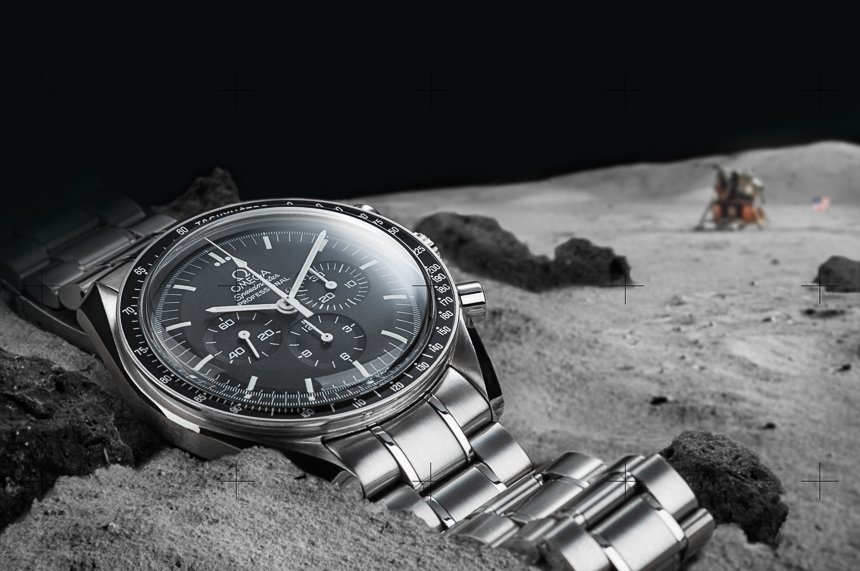
The 1960s were a transformative decade for the OMEGA Speedmaster, as the watch evolved from a motorsport chronograph to a vital tool for space exploration. This period saw significant design changes and technological advancements, culminating in the Speedmaster's legendary status as the Speedmaster Moonwatch Professional.
The Evolution of the Speedmaster During the 1960s
The 1960s began with subtle yet important modifications to the Speedmaster's design. OMEGA introduced several new references, each incorporating small improvements and refinements. Among these, the reference ST105.012 stood out for its pivotal role in the Speedmaster's history.
The Transition to the Speedmaster Professional (Reference ST105.012)
In 1964, OMEGA introduced the reference ST105.012, marking the transition to the Speedmaster Professional series. This model was characterized by a more robust and functional design, tailored to meet the rigorous demands of space missions. The ST105.012 featured an asymmetrical case with crown guards, offering enhanced protection for the pushers and crown. This design change not only improved the watch's durability but also gave it a distinctive and recognizable profile.
Significant Design Changes
Asymmetrical Case
The introduction of the asymmetrical case was a major design evolution. This new case design was more robust and provided additional protection, making the Speedmaster better suited for the harsh conditions of space. The lugs were also slightly extended, improving the watch's overall wearability and comfort.
Professional' Inscription on the Dial
Another significant change was the addition of the 'Professional' inscription on the dial, first appearing on the reference ST105.012. This designation underscored the Speedmaster's elevated status and its suitability for professional use, particularly in the context of space missions.
The Moonwatch: The Speedmaster's Role in the Apollo Missions
The Speedmaster's most famous moment came on July 20, 1969, when it became the first watch worn on the Moon. During the Apollo 11 mission, astronaut Buzz Aldrin wore his Speedmaster reference ST105.012 while walking on the lunar surface, forever cementing the watch's place in history.
Design Adjustments for Space Exploration
In preparation for space missions, the Speedmaster underwent rigorous testing by NASA to ensure its reliability under extreme conditions. These tests included exposure to high and low temperatures, vacuum, humidity, shock, and vibration. The Speedmaster passed these tests with flying colors, leading to its official certification for all manned space missions.
The 1960s were a defining decade for the OMEGA Speedmaster, marked by significant design advancements and its historic role in space exploration. The transition to the Speedmaster Professional series and the watch's certification by NASA highlighted its exceptional durability and precision. As we move into the next decade, we will explore how the Speedmaster continued to innovate and adapt to new challenges, solidifying its status as a timeless classic.
The 1970s: Innovation and Variety

The 1970s were a period of significant innovation and variety for the OMEGA Speedmaster. This decade saw the introduction of new models, each bringing unique design elements and technological advancements. The Speedmaster's versatility and ability to adapt to changing tastes and demands were on full display during these years.
Continued Popularity and New Design Variations
Despite the success of the classic Speedmaster Professional, OMEGA continued to innovate, introducing new models that catered to a broader audience. The 1970s saw the Speedmaster expand beyond its traditional design, incorporating different styles and features to appeal to diverse tastes.
Introduction of the Mark Series
One of the most notable developments in the 1970s was the introduction of the Mark series. These models were designed to offer a fresh take on the Speedmaster's iconic design, incorporating contemporary trends and technological advancements.
The Speedmaster Mark II
Released in 1969, the Speedmaster Mark II featured a distinctive barrel-shaped case, a departure from the traditional round case of the original Speedmaster. You can see the difference when comparing the Speedmaster Professional vs MKII pictures. This design was more aerodynamic and modern, reflecting the evolving tastes of the era. The Mark II retained the tachymeter scale but moved it to the inner bezel, protected by the crystal, making it more durable and legible.
Notable Models and Their Design Elements
The Speedmaster 125
In 1973, OMEGA celebrated its 125th anniversary with the release of the Speedmaster 125, a commemorative edition that showcased the brand's commitment to innovation. This model was the first chronometer-certified automatic chronograph, powered by the Caliber 1041 movement. The Speedmaster 125 featured a robust, square-shaped case and an integrated bracelet, emphasizing its modern and sophisticated design.
Impact of Technological Advancements on Design
The 1970s were a time of rapid technological advancement, and OMEGA leveraged these developments to enhance the Speedmaster's design and functionality. The introduction of new materials, such as more resilient crystals and improved movements, allowed for greater precision and durability.
Enhanced Movements
The decade saw the introduction of automatic movements in the Speedmaster line, offering greater convenience and accuracy. These advancements reflected OMEGA's commitment to staying at the forefront of watchmaking technology while maintaining the Speedmaster's legendary reliability.
The 1970s were a dynamic and innovative period for the OMEGA Speedmaster, characterized by the introduction of new models and design variations. The Mark series and the Speedmaster 125 demonstrated OMEGA's ability to blend tradition with modernity, ensuring the Speedmaster's continued relevance and appeal. As we move into the next decade, we will explore how the Speedmaster evolved to meet the demands of a changing world, solidifying its status as a timeless classic.
The 1980s: A Modern Classic
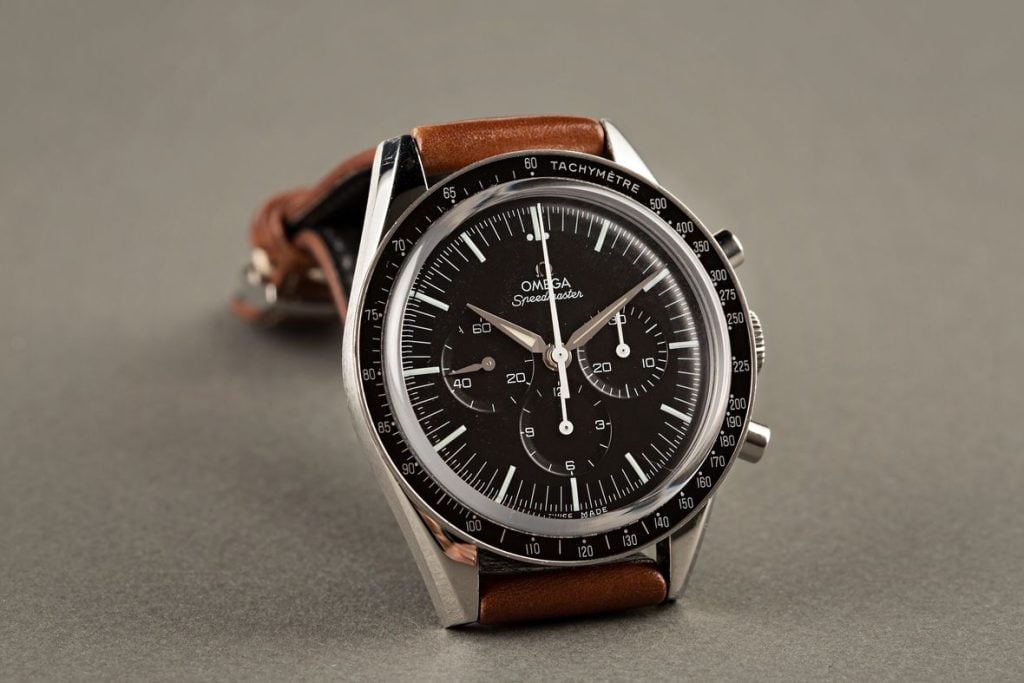
The 1980s marked a period of resurgence for the OMEGA Speedmaster, as the brand focused on re-establishing the classic design elements that had made the watch an icon. This decade saw a renewed appreciation for the traditional Speedmaster aesthetic, alongside subtle updates that kept the watch modern and relevant.
The Resurgence of the Classic Speedmaster Design
As the 1980s progressed, there was a growing appreciation for vintage and classic designs in the watchmaking industry. OMEGA capitalized on this trend by reissuing models that paid homage to the original Speedmaster designs of the 1950s and 1960s. These reissues were met with enthusiasm from collectors and enthusiasts, solidifying the Speedmaster's status as a modern classic.
Reissues and Commemorative Editions
Reissue of the Speedmaster Professional
One of the key highlights of the 1980s was the reissue of the Speedmaster Professional, which closely followed the design cues of the original Moonwatch. This model retained the iconic asymmetrical case, black dial, and tachymeter bezel, while incorporating updated materials and improved movement accuracy. The reissue was a celebration of the Speedmaster's heritage and its continued relevance in contemporary watchmaking.
Limited and Commemorative Editions
In addition to reissuing classic models, OMEGA released several limited and commemorative editions of the Speedmaster during the 1980s. These editions often celebrated significant milestones and events in the Speedmaster's history, such as anniversaries of space missions and collaborations with space agencies. These models featured unique design elements and were produced in limited quantities, making them highly sought after by collectors.
Design Consistency and Subtle Updates
Maintaining Iconic Elements
Throughout the 1980s, OMEGA ensured that the Speedmaster retained its iconic design elements, such as the black dial, luminous hands and markers, and the distinctive tachymeter bezel. These features had become synonymous with the Speedmaster and were essential to its identity.
Introduction of Modern Materials
While the design remained consistent, OMEGA introduced modern materials to enhance the watch's durability and functionality. For example, advancements in crystal technology led to the use of more scratch-resistant materials, improving the watch's resilience to everyday wear and tear.
Enhanced Movements and Technology
The 1980s also saw improvements in the Speedmaster's internal mechanisms. OMEGA continued to refine the manual-wind movements, ensuring greater accuracy and reliability. These enhancements reinforced the Speedmaster's reputation as a high-precision chronograph, suitable for professional and everyday use.
The 1980s were a period of renewal for the OMEGA Speedmaster, characterized by a return to classic design principles and the introduction of subtle yet meaningful updates. This decade solidified the Speedmaster's status as a modern classic, beloved by collectors and enthusiasts alike. As we move into the next decade, we will explore how the Speedmaster continued to evolve, balancing heritage with innovation to remain at the forefront of watchmaking.
The 1990s: Embracing the Past and the Future
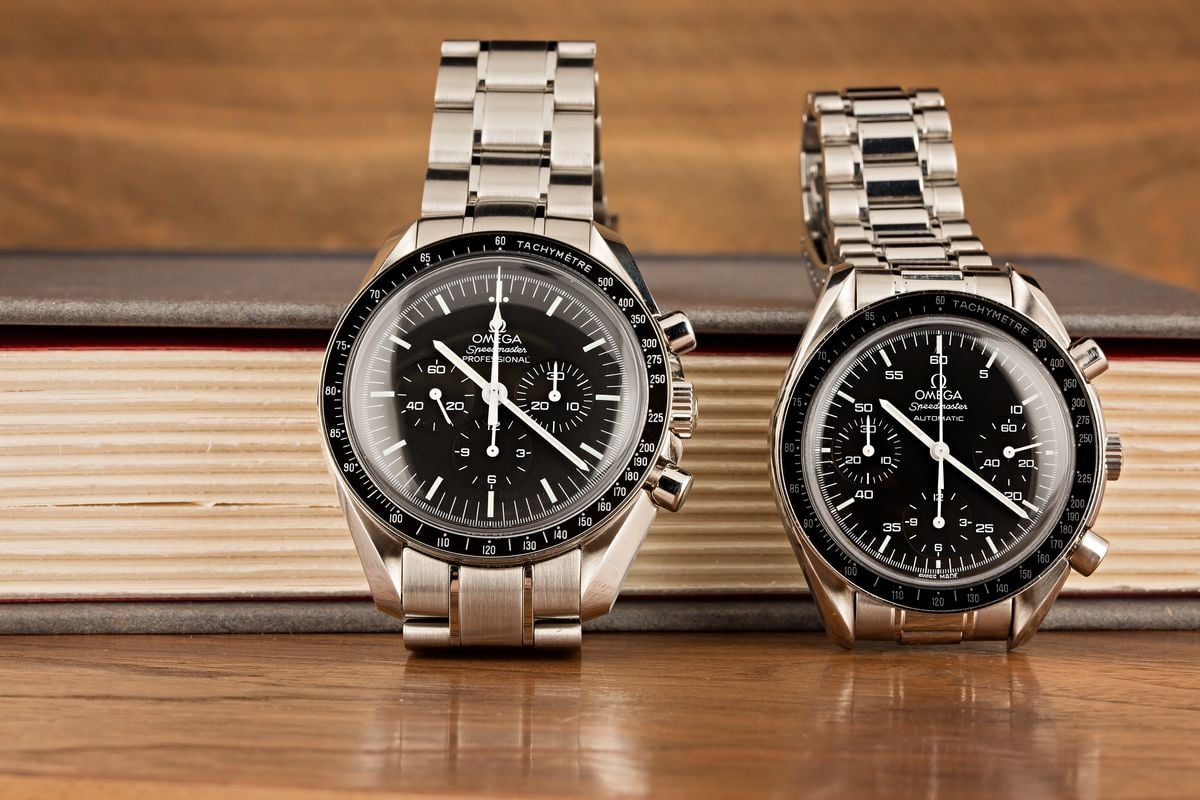
The 1990s were a transformative decade for the OMEGA Speedmaster, as the brand skillfully balanced honoring its storied past with embracing modern innovations. This period saw the introduction of vintage-inspired designs, alongside groundbreaking advancements that pushed the boundaries of watchmaking technology.
Revival of Vintage Designs with Modern Twists
The 1990s marked a renewed interest in vintage designs, and OMEGA responded by reintroducing classic Speedmaster models with modern updates. This approach appealed to both longtime enthusiasts and new collectors, who appreciated the blend of nostalgic aesthetics and contemporary functionality.
Introduction of Limited Editions and Special Releases
OMEGA capitalized on the trend of limited editions, releasing several special versions of the Speedmaster that celebrated its rich history. These models often featured design elements reminiscent of early Speedmasters, combined with modern materials and improved movements.
Noteworthy Models and Design Features
The Speedmaster Professional 'Moonwatch' with Updated Movements
The Speedmaster Professional 'Moonwatch' remained a cornerstone of the collection, with OMEGA introducing updated versions that featured improved movements. These updates enhanced the watch's accuracy and reliability while preserving the iconic design elements that had made the Moonwatch a legend.
The Speedmaster Reduced
The 1990s also saw the introduction of the Speedmaster Reduced, a smaller and more accessible version of the classic Speedmaster. With a 39mm case diameter, the Speedmaster Reduced catered to those who preferred a more compact watch without sacrificing the essential design features of the original. It was powered by an automatic movement, making it a convenient option for everyday wear.
Embracing Modern Technology
Advancements in Movement Technology
OMEGA continued to innovate with the introduction of new movement technologies. The brand's commitment to precision and durability was evident in the incorporation of automatic and chronometer-certified movements across various Speedmaster models. These advancements ensured that the Speedmaster remained at the cutting edge of horological technology.
Limited Editions and Collaborations
The 1990s were notable for several high-profile collaborations and limited editions that celebrated the Speedmaster's heritage. These special releases often featured unique design elements, such as commemorative engravings and exclusive dial colors, making them highly collectible.
Special Editions Honoring Space Missions
OMEGA continued to honor its connection to space exploration with limited editions that celebrated significant anniversaries of NASA missions. These models often included design cues inspired by the original Moonwatch, along with modern enhancements that appealed to collectors and space enthusiasts alike.
The 1990s were a decade of thoughtful innovation and nostalgic revival for the OMEGA Speedmaster. By embracing its storied past while incorporating modern advancements, OMEGA ensured that the Speedmaster remained a beloved and relevant timepiece. As we move into the next decade, we will explore how the Speedmaster continued to evolve, solidifying its status as a timeless classic while pushing the boundaries of watchmaking innovation.
The 2000s: Technological Enhancements

The 2000s ushered in an era of significant technological advancements for the OMEGA Speedmaster, as the brand leveraged cutting-edge innovations to enhance the watch's performance and design. This decade saw the introduction of new movements, materials, and models that reinforced the Speedmaster's reputation as a high-precision timepiece.
Advances in Watchmaking Technology Reflected in Design
OMEGA's commitment to innovation was evident in the technological enhancements that characterized the Speedmaster models of the 2000s. These advancements improved the watch's accuracy, durability, and overall functionality, ensuring it remained at the forefront of horological excellence.
Co-Axial Movements and Their Impact on Speedmaster Designs
One of the most significant developments of the 2000s was the introduction of the Co-Axial escapement, a revolutionary technology that OMEGA integrated into the Speedmaster line. The Co-Axial movement offered several advantages over traditional escapements, including reduced friction, increased accuracy, and extended service intervals. The adoption of this technology marked a major milestone in the evolution of the Speedmaster, enhancing its performance and reliability.
Key Models and Their Unique Features
The Speedmaster X-33
The Speedmaster X-33, also known as the "Mars Watch," was a notable release of the 2000s. Designed specifically for space missions, the X-33 featured a hybrid analog-digital display, providing a range of advanced functions such as multiple time zones, mission elapsed time, and a countdown timer. Its titanium case and bezel offered a lightweight yet durable construction, making it an ideal tool for astronauts and aviation professionals.
The Speedmaster Broad Arrow
In a nod to its heritage, OMEGA introduced the Speedmaster Broad Arrow, a model that paid tribute to the original CK2915 with its distinctive Broad Arrow hands. This model combined vintage design elements with modern innovations, such as the Co-Axial movement and scratch-resistant sapphire crystal. The Broad Arrow was a testament to OMEGA's ability to honor its past while embracing the future.
Introduction of Modern Materials
Use of Ceramic and Titanium
The 2000s saw OMEGA experiment with new materials to enhance the durability and aesthetics of the Speedmaster. Ceramic bezels, known for their resistance to scratches and fading, became a popular addition to several models. Additionally, the use of titanium provided a lightweight and hypoallergenic alternative to stainless steel, appealing to those with active lifestyles.
Enhancements in Durability and Functionality
Improved Water Resistance and Shock Protection
Technological advancements in the 2000s also led to improvements in the Speedmaster's durability. Enhanced water resistance and shock protection ensured that the watch could withstand a variety of challenging environments, from deep-sea diving to space exploration. These enhancements solidified the Speedmaster's reputation as a rugged and reliable timepiece.
The 2000s were a decade of significant technological advancements for the OMEGA Speedmaster. The introduction of Co-Axial movements, innovative materials, and specialized models like the X-33 highlighted OMEGA's commitment to pushing the boundaries of watchmaking. As we move into the next decade, we will explore how the Speedmaster continued to evolve, balancing tradition with modernity to remain an enduring icon in the world of horology.
The 2010s: Heritage and Innovation
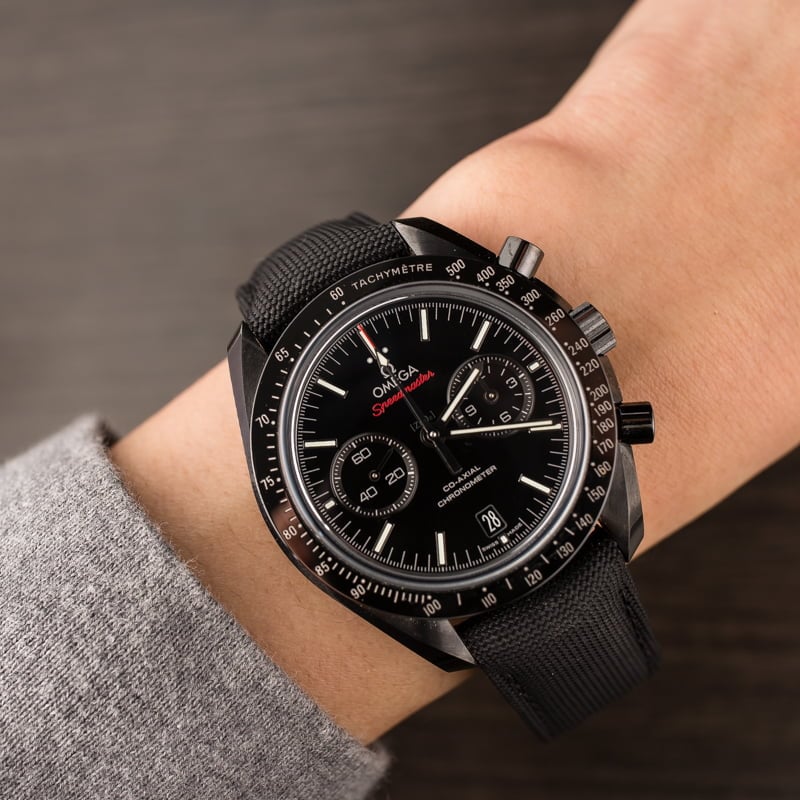
The 2010s marked a period where OMEGA expertly balanced heritage and innovation, bringing the Speedmaster into a new era while honoring its storied past. This decade saw the introduction of advanced technologies, special editions, and unique collaborations that solidified the Speedmaster’s status as both a classic and a cutting-edge timepiece.
Balancing Historical Legacy with Modern Innovation
OMEGA's strategy in the 2010s focused on maintaining the Speedmaster's iconic design elements while integrating modern technological advancements. This approach ensured that the Speedmaster remained relevant to contemporary watch enthusiasts without losing the charm that made it a legend.
The Introduction of the Speedmaster Dark Side of the Moon
One of the standout models of the 2010s was the Speedmaster Dark Side of the Moon, introduced in 2013. This model featured a case made entirely of black ceramic, a first for the Speedmaster line. The use of ceramic not only provided a striking aesthetic but also offered exceptional durability and scratch resistance. The Dark Side of the Moon paid homage to the Apollo 8 mission, where astronauts orbited the dark side of the moon, combining historical significance with modern materials.
Limited Editions and Collaborations
The 2010s saw a surge in limited editions and collaborative efforts, each bringing a unique twist to the Speedmaster lineage. These editions often celebrated significant milestones or partnerships, adding a layer of exclusivity and collectability.
The Speedmaster 'First OMEGA in Space' Edition
In 2012, OMEGA released the Speedmaster 'First OMEGA in Space' edition, commemorating astronaut Wally Schirra's Sigma 7 mission in 1962. This model featured design elements from the original CK2998 worn by Schirra, such as the straight lugs and a symmetrical case, paired with modern upgrades. It served as a bridge between the past and present, appealing to collectors and history enthusiasts alike.
Partnerships with Organizations like NASA
OMEGA continued its collaboration with NASA, releasing special editions that celebrated the brand's long-standing relationship with space exploration. These models often featured unique design elements and commemorative engravings, underscoring the Speedmaster's legacy as the Moonwatch.
Advances in Movement Technology
The Master Chronometer Certification
In the mid-2010s, OMEGA introduced the Master Chronometer certification, a new standard for precision and durability. Several Speedmaster models were updated to include Master Chronometer-certified movements, which underwent rigorous testing by the Swiss Federal Institute of Metrology (METAS). This certification ensured that the watches met the highest standards of accuracy, magnetic resistance, and overall performance.
Notable Releases and Design Philosophy
The Speedmaster Apollo 11 50th Anniversary Edition
In 2019, OMEGA celebrated the 50th anniversary of the Apollo 11 moon landing with a special edition Speedmaster. This model featured a gold bezel, a commemorative engraving, and a movement with a master chronometer certification. It honored one of the most significant achievements in human history while showcasing OMEGA’s commitment to innovation and quality.
The Speedmaster Silver Snoopy Award 50th Anniversary
Another notable release was the Speedmaster Silver Snoopy Award 50th Anniversary edition, celebrating OMEGA's receipt of the Silver Snoopy Award from NASA in 1970. This whimsical and historically significant model featured a detailed Snoopy medallion on the case back and unique dial elements, blending heritage with a touch of playful design.
The 2010s were a decade where OMEGA successfully balanced its rich heritage with modern innovation. The introduction of new materials, advanced movement technologies, and special editions ensured that the Speedmaster remained a beloved icon. As we move into the current decade, we will explore how the Speedmaster continues to evolve, maintaining its status as a timeless classic while embracing the future of watchmaking.
The 2020s: Contemporary Classics
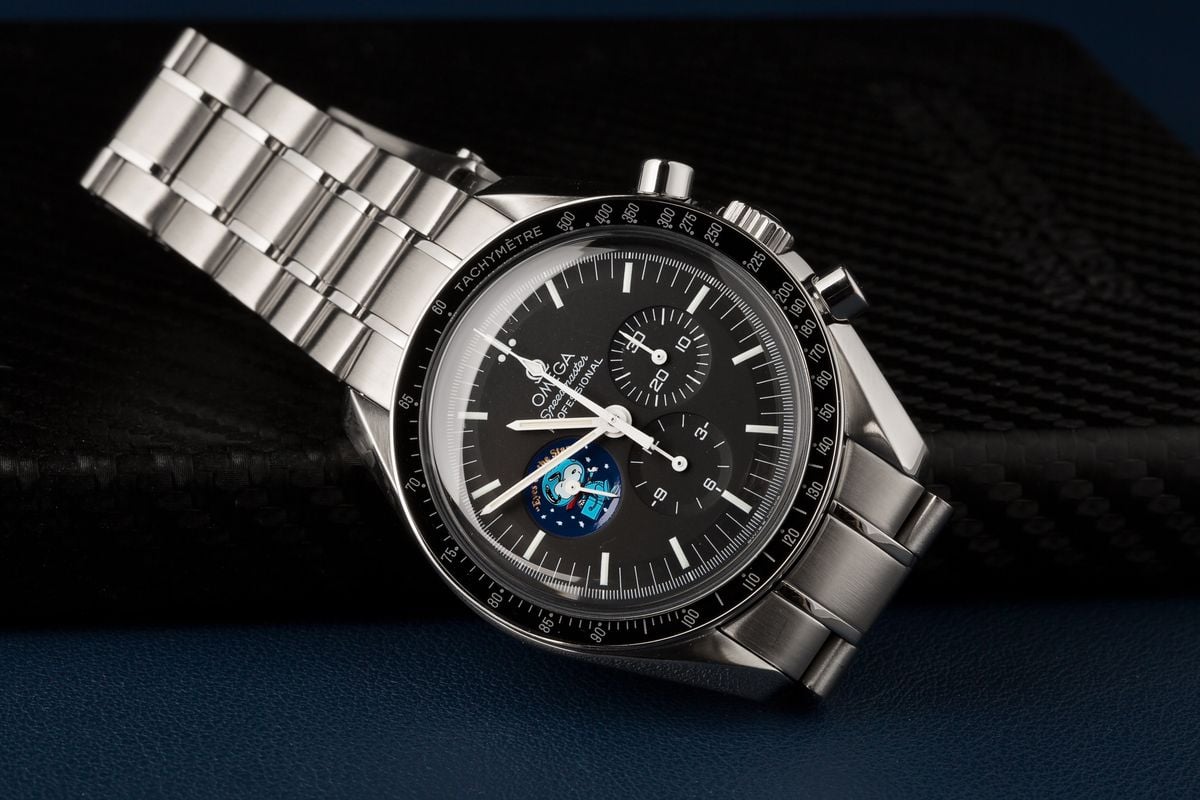
The 2020s have continued to showcase the OMEGA Speedmaster as a blend of timeless design and modern innovation. This decade sees the Speedmaster evolving with new technologies, materials, and designs, ensuring its place as an iconic timepiece for both new enthusiasts and seasoned collectors.
Recent Developments and Latest Designs
As OMEGA continues to push the boundaries of watchmaking, the Speedmaster remains a centerpiece of their innovation. The 2020s have introduced new models and updates that reflect the latest in horological advancements while maintaining the Speedmaster's classic aesthetic.
Integration of Modern Materials
The use of advanced materials such as ceramic, titanium, and sapphire crystal has become more prevalent in the Speedmaster line. These materials enhance durability and scratch resistance, making the Speedmaster more robust for everyday wear and extreme conditions alike.
Notable Releases and Their Design Philosophy
The Speedmaster Professional with Master Chronometer Certification
One of the significant updates in the 2020s is the introduction of the Speedmaster Professional with Master Chronometer certification. This model, powered by the Co-Axial Master Chronometer Calibre 3861, meets stringent standards for accuracy, magnetic resistance, and overall performance. The design stays true to the iconic Moonwatch, with enhancements that cater to modern-day watchmaking standards.
The Speedmaster Silver Snoopy Award 50th Anniversary
Celebrating OMEGA's connection with NASA, the Speedmaster Silver Snoopy Award 50th Anniversary edition remains a highlight. This model features unique design elements like a detailed Snoopy medallion on the case back and a micro-structured depiction of the lunar surface. It captures both the playful and historical aspects of the Speedmaster's legacy.
Advances in Movement Technology
OMEGA continues to innovate in movement technology, with the 2020s seeing the widespread adoption of the Co-Axial Master Chronometer movements. These movements are renowned for their precision, longevity, and resistance to magnetic fields, ensuring that the Speedmaster remains a leader in technical excellence.
The Speedmaster Moonwatch Professional Co-Axial Master Chronometer
The latest iteration of the Moonwatch Professional features the Co-Axial Master Chronometer Calibre 3861. This movement not only meets the rigorous standards of METAS certification but also offers improved shock resistance and enhanced precision. The inclusion of a sapphire crystal and ceramic bezel ring ensures that this model retains its classic look while incorporating cutting-edge technology.
Limited Editions and Special Collaborations
The 2020s have also seen OMEGA releasing several limited editions and special collaborations that highlight the Speedmaster's versatility and enduring appeal.
The Speedmaster Apollo 13 50th Anniversary
Commemorating the 50th anniversary of the Apollo 13 mission, OMEGA released a special edition Speedmaster that features a blue ceramic bezel, a silver dial, and an engraving of the Apollo 13 mission patch. This model celebrates the "successful failure" of Apollo 13, where the Speedmaster played a crucial role in the safe return of the astronauts.
The Future of the OMEGA Speedmaster
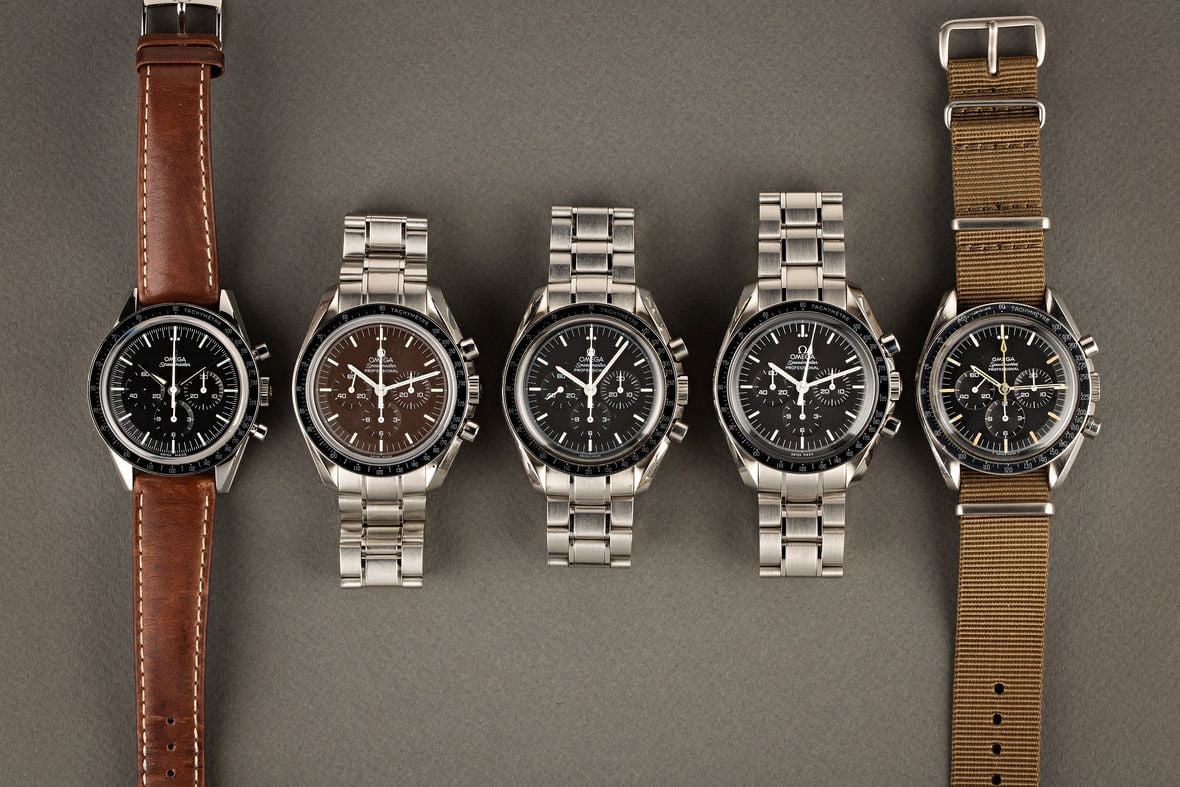
As OMEGA continues to innovate, the Speedmaster remains a cornerstone of their collection. The future promises further advancements in materials, movement technology, and design, ensuring that the Speedmaster will continue to captivate watch enthusiasts for generations to come.
The 2020s have proven that the OMEGA Speedmaster is more than just a watch; it is a symbol of enduring legacy and relentless innovation. By integrating modern technologies and materials while honoring its storied past, the Speedmaster remains a timeless classic that is poised to continue its journey through the decades.
About Bob's Watches Editorial
With over two decades of experience in the luxury watch industry, the Bob's Watches Editorial Team stands at the forefront of watch expertise and insight. Our team, composed of seasoned watch enthusiasts, skilled horologists, and knowledgeable industry insiders, is dedicated to bringing you the latest and most accurate information in the world of luxury timepieces. We pride ourselves on our meticulous attention to detail and our unwavering commitment to authenticity. Our editorial content is a reflection of our passion for luxury watches and our dedication to providing our readers with comprehensive, unbiased, and up-to-date information. Our expertise spans a wide range of topics, including in-depth reviews of the latest models, historical retrospectives of iconic timepieces, and insightful analyses of market trends. We are also renowned for our detailed guides on watch maintenance and investment advice, making us a trusted resource for both seasoned collectors and new enthusiasts alike. As thought leaders in the watch industry, we understand the importance of staying ahead of the curve. That's why we continually update our knowledge and skills, ensuring that our readers receive the most current and relevant information. Whether you're seeking advice on your next luxury watch purchase or looking to deepen your understanding of watch craftsmanship, the Bob's Watches Editorial Team is here to guide you.